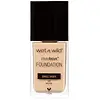Colourpop Pretty Fresh Hyaluronic Hydrating Foundation Versus Wet n Wild Photo Focus Matte Foundation
What's inside
What's inside
 Key Ingredients
Key Ingredients

 Benefits
Benefits

 Concerns
Concerns

 Ingredients Side-by-side
Ingredients Side-by-side

Water
Skin ConditioningCyclopentasiloxane
EmollientIsopentyldiol
HumectantGlycerin
HumectantDiisopropyl Dimer Dilinoleate
EmollientPolymethylsilsesquioxane
Hdi/Trimethylol Hexyllactone Crosspolymer
PEG-10 Dimethicone
Skin ConditioningPolyglyceryl-6 Polyricinoleate
EmulsifyingDisteardimonium Hectorite
StabilisingSodium Chloride
MaskingCitrullus Lanatus Fruit Extract
Skin ConditioningSodium Hyaluronate
HumectantLens Esculenta Fruit Extract
Skin ConditioningCocos Nucifera Water
MaskingMalus Sylvestris Flower Extract
AntioxidantSodium Lactate
BufferingSodium PCA
HumectantCocos Nucifera Fruit Juice
EmollientPhenoxyethanol
PreservativeCaprylyl Glycol
EmollientAluminum Dimyristate
Emulsion StabilisingTriethoxycaprylylsilane
Potassium Sorbate
PreservativeDisodium Stearoyl Glutamate
CleansingBHT
AntioxidantTrisodium EDTA
Hexylene Glycol
EmulsifyingIron Oxides
CI 77891
Cosmetic ColorantWater, Cyclopentasiloxane, Isopentyldiol, Glycerin, Diisopropyl Dimer Dilinoleate, Polymethylsilsesquioxane, Hdi/Trimethylol Hexyllactone Crosspolymer, PEG-10 Dimethicone, Polyglyceryl-6 Polyricinoleate, Disteardimonium Hectorite, Sodium Chloride, Citrullus Lanatus Fruit Extract, Sodium Hyaluronate, Lens Esculenta Fruit Extract, Cocos Nucifera Water, Malus Sylvestris Flower Extract, Sodium Lactate, Sodium PCA, Cocos Nucifera Fruit Juice, Phenoxyethanol, Caprylyl Glycol, Aluminum Dimyristate, Triethoxycaprylylsilane, Potassium Sorbate, Disodium Stearoyl Glutamate, BHT, Trisodium EDTA, Hexylene Glycol, Iron Oxides, CI 77891
Isododecane
EmollientCyclopentasiloxane
EmollientWater
Skin ConditioningGlycerin
HumectantCyclohexasiloxane
EmollientDimethicone
EmollientButylene Glycol
HumectantPEG-10 Dimethicone
Skin ConditioningDisteardimonium Hectorite
StabilisingAdipic Acid/Neopentyl Glycol Crosspolymer
Caprylyl Glycol
EmollientSilica
AbrasiveSodium Chloride
MaskingSorbitan Sesquioleate
EmulsifyingLecithin
EmollientPolyglyceryl-4 Isostearate
EmulsifyingCetyl PEG/PPG-10/1 Dimethicone
EmulsifyingHexyl Laurate
EmollientPolysilicone-11
Isopropyl Titanium Triisostearate
EmollientLaureth-12
EmulsifyingPhenoxyethanol
PreservativeEthylhexylglycerin
Skin ConditioningTitanium Dioxide
Cosmetic ColorantMica
Cosmetic ColorantIron Oxides
Isododecane, Cyclopentasiloxane, Water, Glycerin, Cyclohexasiloxane, Dimethicone, Butylene Glycol, PEG-10 Dimethicone, Disteardimonium Hectorite, Adipic Acid/Neopentyl Glycol Crosspolymer, Caprylyl Glycol, Silica, Sodium Chloride, Sorbitan Sesquioleate, Lecithin, Polyglyceryl-4 Isostearate, Cetyl PEG/PPG-10/1 Dimethicone, Hexyl Laurate, Polysilicone-11, Isopropyl Titanium Triisostearate, Laureth-12, Phenoxyethanol, Ethylhexylglycerin, Titanium Dioxide, Mica, Iron Oxides
 Reviews
Reviews

Ingredients Explained
These ingredients are found in both products.
Ingredients higher up in an ingredient list are typically present in a larger amount.
Caprylyl Glycol is a humectant and emollient, meaning it attracts and preserves moisture.
It is a common ingredient in many products, especially those designed to hydrate skin. The primary benefits are retaining moisture, skin softening, and promoting a healthy skin barrier.
Though Caprylyl Glycol is an alcohol derived from fatty acids, it is not the kind that can dry out skin.
This ingredient is also used as a preservative to extend the life of products. It has slight antimicrobial properties.
Learn more about Caprylyl GlycolCyclopentasiloxane, or D5, is a silicone used to improve texture of products and trap moisture.
D5 is considered lightweight and volatile. Volatile means it evaporates quickly after application. Once evaporated, D5 leaves a thin barrier that helps keep skin hydrated.
It is also an emollient. Emollients help soften the skin and prevent water loss. Silicones create a silky texture in products. D5 helps other ingredients become more spreadable.
Studies show D5 is safe to use in skincare products. We recommend speaking with a skincare professional if you have concerns.
Learn more about CyclopentasiloxaneDisteardimonium Hectorite comes from the clay mineral named hectorite. It is used to add thickness to a product.
It can also help stabilize a product by helping to disperse other ingredients.
Hectorite is a rare, white clay mineral.
Learn more about Disteardimonium HectoriteGlycerin is already naturally found in your skin. It helps moisturize and protect your skin.
A study from 2016 found glycerin to be more effective as a humectant than AHAs and hyaluronic acid.
As a humectant, it helps the skin stay hydrated by pulling moisture to your skin. The low molecular weight of glycerin allows it to pull moisture into the deeper layers of your skin.
Hydrated skin improves your skin barrier; Your skin barrier helps protect against irritants and bacteria.
Glycerin has also been found to have antimicrobial and antiviral properties. Due to these properties, glycerin is often used in wound and burn treatments.
In cosmetics, glycerin is usually derived from plants such as soybean or palm. However, it can also be sourced from animals, such as tallow or animal fat.
This ingredient is organic, colorless, odorless, and non-toxic.
Glycerin is the name for this ingredient in American English. British English uses Glycerol/Glycerine.
Learn more about GlycerinPeg-10 Dimethicone is silicone with conditioner and emulsifier properties. It mostly acts as an emollient in skincare and and humectant in haircare.
According to the manufacturer, acidic formulations decrease the stability of this ingredient. It works best in neutral or near neutral formulations.
Phenoxyethanol is a preservative that has germicide, antimicrobial, and aromatic properties. Studies show that phenoxyethanol can prevent microbial growth. By itself, it has a scent that is similar to that of a rose.
It's often used in formulations along with Caprylyl Glycol to preserve the shelf life of products.
Chances are, you eat sodium chloride every day. Sodium Chloride is also known as table salt.
This ingredient has many purposes in skincare: thickener, emulsifier, and exfoliator.
You'll most likely find this ingredient in cleansers where it is used to create a gel-like texture. As an emulsifier, it also prevents ingredients from separating.
There is much debate on whether this ingredient is comedogenic. The short answer - comedogenic ratings don't tell the whole story. Learn more about comegodenic ratings here.
The concensus about this ingredient causing acne seems to be divided. Research is needed to understand if this ingredient does cause acne.
Scrubs may use salt as the primary exfoliating ingredient.
Learn more about Sodium ChlorideWater. It's the most common cosmetic ingredient of all. You'll usually see it at the top of ingredient lists, meaning that it makes up the largest part of the product.
So why is it so popular? Water most often acts as a solvent - this means that it helps dissolve other ingredients into the formulation.
You'll also recognize water as that liquid we all need to stay alive. If you see this, drink a glass of water. Stay hydrated!
Learn more about WaterThis ingredient is a combination of red, black, and yellow iron oxide pigments. This combination of colors is usually found in foundation, because it results in a "skin" color.